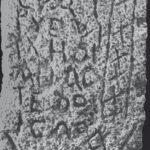| Artefact ID | 1286 |
| TM ID | TM 701029 |
| Findspot (DEChriM ID) | 68 (al-Filusiyya) | Class | Funerary element, Textual |
| Material | Stone |
| Writing medium | Inscription |
| Text content | Subliterary |
| Language | Greek |
| Description | SEG LIX 1877: Epitaph of Hedeia Dahari & Di Segni 2009, no. 5: Complete anthropomorphic stela of beach-rock consisting of a rectangular slab with a trapezoid head at the top and a square protrusion at the bottom. H. 96 cm; W. 40 cm; Th. 12 cm. The head has no face but bears a large Jerusalem cross, deeply incised and filled with red paint. On the rectangular body a tall narrow rectangular frame is incised; within it are six X-shaped characters (for the different interpretations of which, see comm. in ed.pr.). The epitaph is set in six short lines on the left of the frame. The letters are irregular and uncouth, showing characteristics of cursive script. The spelling is very bad and some letters are transposed. Same consolatory formula as in the other steles sharing the same provenance – a combination restricted to the northern coast of Sinai (el-Huweinat and el-‘Arish) according to ed.pr.: εὐμοίρει, εὐψύχει, οὐδεὶς ἀθάνατος, “fare thee well, be of good courage, nobody is immortal”, accompanied by the name of the deceased in vocative. Here, the deceased is said ἄωρε, meaning she died before her time. |
| Selection criteria | Christian terms/formulas/concepts, Christian symbols/gestures/isopsephy |
| Date from | 350 |
| Date to | 499 |
| Dating criteria | Phrasing and palaeography point to 4th-5th c. according to ed. pr. |
| Absolute/relative date | Relative date |
| Archaeological context | SEG LIX-1873-1882: One of the ten anthropomorphic stelai acquired in the antiquities market in the 1970s by the Israel Museum in (Jerusalem) and the Israel Antiquities Authority; returned to Egypt in 1993; all stelai come from the Byzantine nekropolis at el-Huweinat 2 km south of Ostrakine (east of Lake Sirbonitis = Sbakhat el-Bardawil; northern Sinai). |
| Accession number | Formerly: Jerusalem, Israel Antiquity Authority 4472 b. Returned to Egypt in 1993 (present location unknown). |


 Json data
Json data




